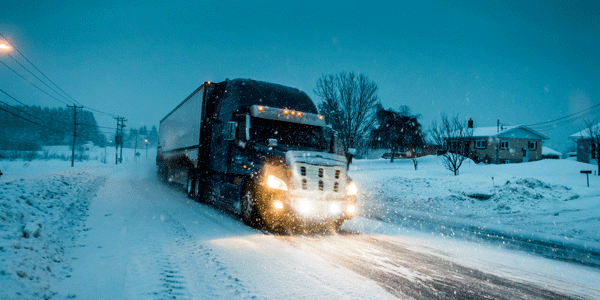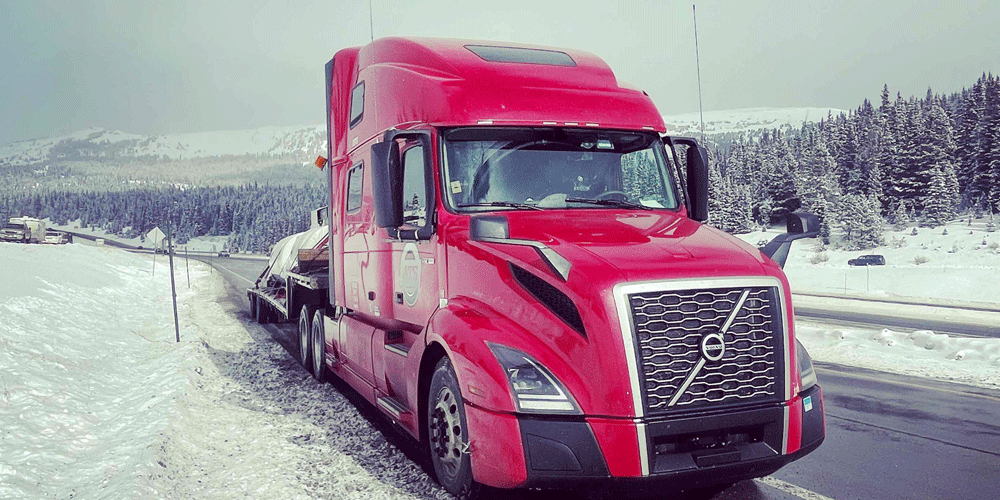The 2025 Winter Truck Driving Guide Every Driver Should Read
Jackie is a driver manager on the specialized side and works on wind projects. She works together with customer service representatives, permit coordinators and support departments to provide the best driver experience. She loves working as a team to ensure her drivers are safe, successful and happy. Drivers aren’t a number to Jackie. They’re very important people to her and she loves getting to know them, as well as working together to work through issues and helping them maximize productivity so they can make money to go home to their families. She started with ATS in July 2018. Prior to that, she worked in sales, where she focused on building long and lasting relationships.
Key Takeaways:
- Thorough, winter-specific pre-trip prep is key to staying safe and keeping your equipment in good condition.
- Adjust your driving habits: Slow down, increase following distance, avoid cruise control, and use engine braking instead of hard braking.
- Carry essential winter gear to ensure you'll be comfortable and safe working in cold weather, or in the event of a breakdown.
- Know when to stop rolling. If conditions feel unsafe, shut it down, keep dispatch updated, and wait it out.
Every year, truckers brave cold, snowy, windy, and icy weather to keep freight moving across the country. While it's true that some drivers enjoy the challenge, it's understandable to be wary of wintertime driving.
Hazards like snow-covered roads and black ice mean delays, breakdowns, and accidents are all more likely — and freezing temperatures can take a toll on both you and your truck.
At Anderson Trucking Service (ATS), safety has been a core value for 70 years. As our founder Harold Anderson said, “There is no load so hot that it won’t cool off in the ditch.” In other words, no freight is worth risking your life.
But staying safe and in good working order requires extra preparation, the right tools, and a few winter-weather best practices. This comprehensive guide will help you feel in control and prepared all winter long, featuring expert tips from ATS driver managers, our safety team, and experienced drivers.
That includes winter-specific pre-trip additions, winter driving best practices, an FAQ on black ice, an emergency kit list, and more. Let's dive in!
Pre-Trip Prep for Winter Trucking
When driving in areas that experience true winter, your maintenance routine and pre-trip checklist should directly address the challenges of your environment — like freezing, fuel gelling, and the risks of tarping in slick, icy conditions.
Here are some truck maintenance tips to keep your truck running optimally in wintertime:
- Fuel daily with treated fuel: Use winter-blended diesel and anti-gel additives to prevent clogged lines. Keep your tanks at least half full and carry a bottle of Diesel 911 just in case.
- Inspect tires & chains: Make sure your tread depth is at least 6/32", air pressure is correct, and chains are ready if you'll be running in mountain passes.
- Brake & air line freeze protection: Frozen brakes can ruin your day. Some drivers use rubbing alcohol in their air system, others ride the brakes slightly to dry them off before parking. If your brakes freeze, gentle hammering on the drum or rocking the truck may help release them.
- Wipers, defrosters & fluids: Replace worn wiper blades, top off washer fluid with winter mix, and confirm defrosters are working properly. Remember that cold weather can also weaken batteries, so be sure to test yours before heading out.
- Lights & visibility: Keep headlights, reflectors, and mirrors clear of snow and ice. Visibility isn't just about you; it also helps others see your truck in low-light or white-out conditions.
- Flatbed tarping & trailer prep: Tarping in freezing temps can be brutal — and dangerous. If possible, secure loads indoors and keep tarps warm to avoid cracking or stiffening. Carry de-icer to clear your trailer, and cat litter or sand to get traction if you're stuck.
- Check road & weather conditions: Don't just check in the morning. Conditions change fast, so check SafeTravelUSA and 511 regularly throughout the day. Firsthand road reports are invaluable, so talk to other drivers at truck stops to get an idea of what lies ahead.
Remember that these tips are recommended in addition to your standard pre-trip inspection, not instead of one. Winter is no time to skip this critical step in your process, as it keeps you, your load, and the motoring public safe.
Essential Winter Truck Driving Tips
Winter roads demand a different mindset behind the wheel. Even the most experienced trucker needs to adjust their driving style when snow and ice hit. Here are a few key safety practices every driver should follow:
- Slow Down: Veteran drivers know this pro tip — if you're questioning whether you should be slowing down, you should already be slowing down. It's always better to be safe than sorry. Keep your speed in check, especially during active winter weather like snow or ice storms and white-out conditions.
- Leave Extra Space: Icy roads double your stopping distance. Drop your speed and aim for at least 10 seconds of following distance behind the vehicle in front of you. That extra cushion could be the difference between a near-miss and a collision.
- Use Engine Braking Instead of Hard Brakes: Sudden braking is a recipe for jackknifing. Instead, let your engine do the work by easing off the throttle early and downshifting gradually. This keeps you in control and reduces the risk of sliding.
- Stay Visible in Low-Visibility Conditions: Snow and fog can make you invisible fast. Keep headlights, marker lights, and mirrors clear of ice and snow. A quick wipe during fuel stops or rest breaks can drastically improve your visibility behind the wheel and make sure other drivers can see you.
- Avoid Cruise Control on Slick Surfaces: Cruise control can accelerate unexpectedly on icy patches. Always keep full manual control of your rig when roads are slippery.
- Keep a Light Touch on the Wheel: Over-steering is just as dangerous as under-steering. Make slow, steady adjustments — especially on bridges, shaded areas, and ramps where black ice loves to hide.

Black Ice FAQ: What Truck Drivers Need to Know
Black ice is one of the most dangerous winter hazards for truck drivers, because you often don’t see it until you’re already on top of it. It forms when moisture freezes into a thin, nearly invisible layer on the road, often at night and early morning when temperatures drop.
If conditions make you suspect black ice, drive as though it’s already there. That means slower speeds, increased following distance, and no cruise control.
Here are the answers to some of the most asked questions about black ice and trucking:
Where does black ice usually hide?
Black ice is more likely to form on shaded sections of highways and rural roads, and on bridges and overpasses; due to their height, they freeze before the rest of the road. Areas near rivers, lakes, or open fields where moisture can collect are also at a heightened risk for black ice formation.
When is black ice most likely to form?
Black ice is a winter weather condition most likely to occur after a light rain (or "freezing rain" that freezes as soon as it hits the ground,) or a thaw/refreeze cycle, which typically happens overnight. In the parts of the U.S. that experience winter, these conditions can occur starting as early as September and ending in April or May.
How can truck drivers spot black ice?
Stay alert. Watch for road surfaces that look darker, shinier, or appear wet when it's below freezing. Pay attention to your mirrors; if there's ice forming on them, it's likely forming on the pavement, too. Finally, notice how the vehicles around you behave. If cars ahead of you sway or brake unexpectedly, it could be black ice.
What should truckers do if they hit black ice?
Don't overreact — smooth, minimal corrections are key. Keep the steering wheel straight and your hands steady. Calmly ease off the accelerator, letting your truck slow down naturally. Hard braking can cause a skid or jackknife, so avoid braking or sudden gear changes. Instead, gently steer into the slide if your trailer starts to drift.
Winter Gear Every Trucker Should Carry
Unless you’re strictly moving freight in the South year-round, you’re going to want to have some cold-weather gear and extras on hand from September through April.
Many drivers from the South or West Coast don’t realize just how cold it gets in the Midwest and Eastern Seaboard, so they don’t know what to keep in their trucks. Consider this a starter list of essentials that should feature in any emergency kit for truckers:
- Extra truck equipment and fluids: Extra equipment and parts, from windshield wipers to fuel filters to airline antifreeze, should be in your truck all winter long.
- Winter gloves (x2): Always keep at least two pairs of gloves in your truck. When one pair of gloves is wet, you can set it by the heater in your truck to dry and use your spare set. Snowmobiling gloves work well, as they allow mobility while offering frostbite protection.
- Hand warmers: Keep a few packs of hand warmers in your truck to use as glove or boot inserts when you're out in the cold.
- Winter boots: Climbing up and down from trailers in slick winter weather can be dangerous. Purchase boots with a good grip, and if you can, a set of ice grips or ice cleats. They fit over your boot and provide additional traction on slippery surfaces.
- Extra warm clothing: Layers are your friend when the temperatures drop. Long underwear is an excellent base layer. If you run in cold weather frequently, it's a good idea to invest in some good-quality thermal gear.
- Extra blankets: If your truck engine is off, things can get seriously chilly fast. A few thick, warm blankets will go a long way toward staying comfortable. Also consider stashing a few emergency (Mylar) blankets in your truck, too.
- Ladder: A ladder always makes tarping and securing easier, but it’s especially essential in the winter. Using it will decrease your chances of slipping and falling by reducing attempts climb over the load to reach something.
- Ice scraper and snow shovel: These tools will help you keep your truck clean and clear of ice and snow, especially after major snowstorms that dump more than a foot of snow on and around your truck.
- Propane torch: If you need to thaw frozen parts of your truck, like valves, you'll be grateful for the propane torch in your kit.
- Cat litter or sand: These materials can provide much-needed traction if you find yourself stuck in the snow.
- Flashlight: Keep a flashlight and extra batteries in your truck, but also consider getting a headlamp or other lighted, hands-free gear to help with truck repairs or maintenance in the dark.
- Candles: Always keep a few candles (and matches or a lighter!) for heat and light in the event you're operating without any light sources, battery-powered or otherwise.
- Portable phone charger or charging case: Preferably solar powered. This accessory will ensure your phone stays juiced even if you end up on the side of the road in a winter storm.
- Extra food and water: Keep plenty of water and non-perishables stocked up to last for a few days. Think crackers, peanut butter, bread, granola bars, and things you can quickly microwave, like single-serve macaroni and cheese or ramen cups.

Knowing When to Park Your Rig
If you feel uncomfortable on the road, shut it down. No load is worth your life, and winter driving sometimes means delays — it's just part of the job.
When in doubt, talk to your dispatcher about your concerns. They'll help you find the safest path forward — which may mean not moving forward while you wait out the weather.
When you do park:
- Pick your spot wisely. Back into spaces so you can pull out easily once the weather clears.
- Let the plows work. Give them room to clear the lot and roads.
- Stay active. If you’re stuck for more than a day, walk around the truck for fresh air and do a quick check on lights, brakes, and lines.
- Keep dispatch in the loop. Let them know you’ve parked so they can adjust plans. Good dispatchers would rather reschedule than risk your safety.
The bottom line? Trust your instincts. If you're asking yourself whether it's too risky to keep driving, it probably is.
Follow Best Practices to Stay Safe on Winter Roads
Winter trucking is tough, no doubt about it. From black ice and frozen brakes to blizzards and whiteouts, the challenges can feel endless.
But at the end of the day, no load is worth risking your life, and no schedule is worth pushing through unsafe conditions. With the right preparation, gear, and mindset, you can face those conditions with confidence.
Prepare yourself, know what you’re driving into, and take the extra time required to operate as safely as possible. These tips will help you prevent costly breakdowns and get home safe.
Looking for more winter driving tips? Whether you’re driving through snow or icy roads, knowing how to apply chains or cables can make all the difference.
Check out our video on tire chain installation. An expert member of the ATS safety team will take you through a real tire cable install step by step, so you can feel confident handling the process on your own this winter


